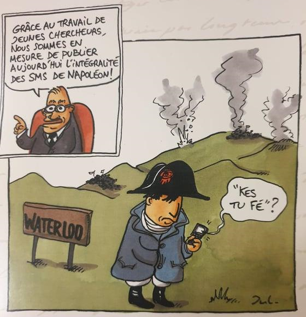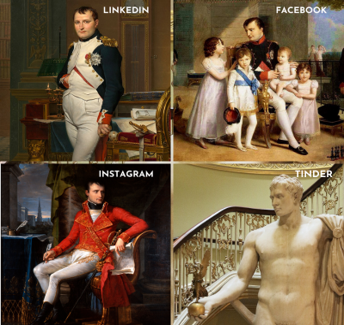Back to the Future…
Now I come to think of it, maybe Napoleon kept his hand inside his waistcoat, not for obscure style reasons or because of stomach pain, but rather to keep track of the social media alerts on his smartphone vibrating in his inside pocket!

Seriously though, if Napoleon had been born in the 21st century, he would certainly have been fascinated by the powerful and influential role that Facebook plays, where today’s Internet users not only publish often intimate details of their daily lives, but where they in turn can become easy prey to the targeted advertising of brands and institutions. It is not hard to imagine the millions of “likes” that could have been clocked up by charming images of the Emperor at home with the Imperial family, or the considerable number of “views” that would have been generated by livestreaming on Facebook the new French Emperor’s coronation ceremony at Notre-Dame. A few years earlier, the fiery and precocious young General Bonaparte would naturally have wanted to boost his popularity via his Instagram account, and he would definitely not have missed the opportunity to post a pompous selfie in front of the pyramids of Egypt with an inspiring quotation to boot; and no doubt, we’d all have dutifully shared and commented on it.
Social networks are all about aesthetics, emotion, and influence. The ability to portray yourself (or someone else) in carefully staged (and edited) photos or footage and thus to reach out to thousands of people the world over in a few clicks is a powerful tool. Painters like Ingres, Gros, Isabey and Meynier would not have missed the potential for artistic propaganda. On Instagram, Josephine would surely have been the perfect “fashion influencer”. The Emperor, mindful of his e-reputation as a “thought leader”, could have handed out valuable management advice on LinkedIn [the favourite professional network for ultra-connected executives and managers]. And since Twitter is the medium “par excellence” for immediate and often “viral” information, a #MassesofGranite officially launching the campaign of Napoleon’s vast institutional project would have surely broken all records for retweets. Finally, the Empire’s most eligible bachelor could even have settled his choice of fiancée by consulting Anna Pavlovna and Marie-Louise’s profiles on the dating app Tinder. And after his death, Napoleon’s memorialist Las Cases would surely not have let the Emperor’s various profiles simply fade into oblivion, far from it. But maybe I’m getting a bit carried away with myself [insert appropriate emoji here 😉]

Napoleon weaving his web, from yesterday to tomorrow…
Even without 4G and Wi-Fi, the Emperor found his own quite extraordinary path to glory and ultimately to posterity. Making the most of all the means available at the time, Napoleon did not lack imagination when it came to cultivating his public image, from his first military exploits to his political testament on St Helena. Right from the First Italian campaign, he had the intuition to build the support of his troops and public opinion by using a whole range of tools and ideas (from his proclamations to the army, the Courrier de l’armée d’Italie, to the Bulletins of the Grande Armée). The use of the press and the arts complemented a well-oiled propaganda system, both from a technical point of view (use of the latest telecommunication tools to transmit information more quickly) and from a strategic one. Marketing professionals of the 21st century would confirm that he knew how to organise what they warmly recommend to their clients, namely: attractive “multi-channel campaigns”, carried out with inventiveness, audacity, and an understanding of his audience. And moreover, choosing for each targeted audience the most appropriate channel, based on the “data” or information available on these “contacts”, and by transmitting via each of these channels the message deemed most relevant for the target audience. It is therefore not at all surprising that today the figure of the Emperor of the French, who was famous for “roughing it” with soldiers, now rubs shoulders and shakes hands with a vast and varied audience, and he is within a click’s reach of everyone who has access to the internet, at any time, anywhere.
Valérie Durand, January 2020 (translation RY with PH)
Valérie Durand is in charge of social networks for the Fondation Napoléon.


